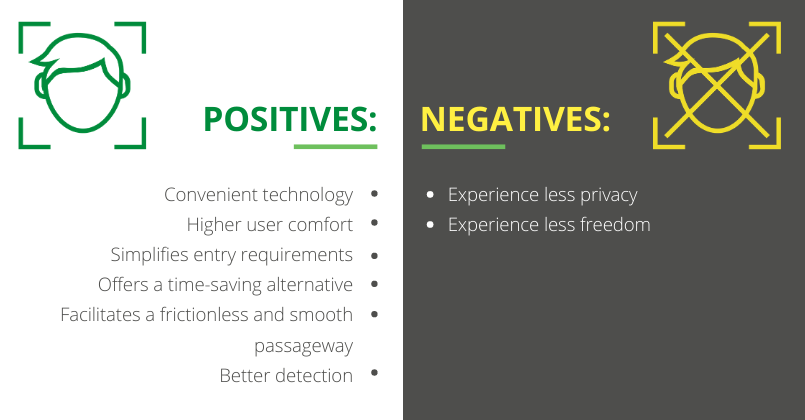Boon Edam Blog | May 2020
In our first blog “The Touchless Evolution, Luxury to Necessity” we brought you up to speed on the history of ‘contactless’ and ‘touchless’ security. For those who missed it last week, you can catch up here to explore how futuristic, high-tech solutions have become part of our everyday life.
In this blog, we will dive deeper into the critical (and highly relevant) topic of facial recognition, and learn how the future of “Touchless” is evolving around this cutting-edge innovation.
Seeing the World from a Different Perspective
The origin of facial recognition stems from the dream of Woodrow ‘Woody’ Wilson Bledsoe to create a computing device that he called a “computer person”.1 The essence of such a device would be to read distinct patterns in a picture and transform them into binary lines of code. After matching these specific strings of code with a database, Woody’s imaginary device (mounted on his glasses!) would know what or who was in front of him and whisper this into his ears through an attached earplug.
Even though the creation of this “computer person” would seem to fit best in Isaac Asimov’s next bestseller, recent years have shown tremendous development in facial recognition software and applications. And if it is up to us – this technology is set to skyrocket.
Facial Recognition Opportunities - Which Applications have we Seen so Far?
With the first developments in facial recognition going back as far as the 1960s, the technology only began to become part of our everyday lives in the past couple of years. However, when giving it some deeper thought, we can already imagine many uses for this powerful software application.
Personal Use
One of the first things that comes to mind is a device that many of us keep in our pockets, charge every night, or even are reading this blog on right now. Most modern mobile phones offer the possibility to not only unlock using a passcode but also by merely looking at it. If this feature was entirely new for us, we might be a bit hesitant to use it, but a trip down memory lane shows us it was not the first time our devices could have been used to recognise faces.
If we go back about a decade, we see somewhat of a predecessor to this feature. After posting a picture on your social media account, it asked you if you wanted to tag people that were in it. Surprisingly, your computer would already mark the faces with squares, and you only had to complete the picture by adding the correct name to the correct face. Exciting right?
But it goes beyond that. While some of us are not comfortable with the pop-up advertisements offering us the very things we were searching for just an hour ago, this actually makes our lives a little easier. If we go to the store, we would also like the vendor to help us select the things we want. While it might seem a little farfetched now, companies are already looking into the possibilities of using facial recognition to make adverts even more personalised.
Forensic Search
Another subject that will come up while thinking about facial recognition is the episode of the old detective you saw on the television last night. One of the first moments we noticed the possibilities of facial recognition was when we heard about a high-tech machine that was able to recognise the victim from a database of known criminals. Even if it was surrealistic back then, Interpol, as an example, has made this technology become a reality in the recent past.3
We crank the use of facial recognition in forensics up even further. Do you remember the missing children adverts that were printed on the back of a carton of milk? Or a police officer on the television asking you to look out for a wanted criminal? Using facial recognition on everyday surveillance cameras could make it possible to track down a person that we desperately need to find.
Mass Surveillance
Using facial recognition software on images that are shot by surveillance cameras opens up another exciting opportunity. While forensics use facial recognition to analyse images in retrospect, mass surveillance applications use real-time footage to see if a person of interest is spotted in a specific location.
There are many reasons why someone may want to detect if someone is present in a particular area. It might be because they want to locate a VIP to give that person special treatment. Another reason could be they observe a known offender and want to prevent this person from doing any harm.
This way of using facial recognition can even be upscaled to create an environment in which law enforcement can be automated by setting up a set of rules for specified locations. Whenever a person shows disobedient unlawful behaviour, the software can register a name and store this in a database.
Access Control
Having an application that combines a set of rules with real-time facial recognition is also used in an access control environment. Similar to the way you can unlock your phone while looking at it, security gates at airport customs will compare your face with your identification. In most cases, the software will grant you access to the country, but if you are not recognised as being the same person as the owner of the passport, you will have to prove it to the customs officers.
Facial recognition software is also found in other entrance solutions. Examples are mainly found on sites that require a high-level of security. But there is more to it as data generated by facial recognition software can be used for more than just opening a door or gate. One can think of knowing who to evacuate in the case of an emergency or regulating the office climate based on who is in the building.
The Light and Dark Sides of Facial Recognition
While Woody’s dream shifts from being science-fiction to reality, and even a commodity, we might ask ourselves the question of what the impact of facial recognition might be on humankind. As you have just read, there are a lot of positives to the technology but also some possible negative aspects to evaluate before concluding the integration of any facial recognition:

Touchless and Frictionless will be Part of the new Normal
While facial recognition has taken a flight over the past few years, it is still somewhat of a rare, high-end application in the world of access control. However, the technology is starting to prove itself as a reliant, robust software solution with many applications in different sectors. It opens the door to a future in which we are surrounded by computer friends that help us by making our lives easier, safer and more secure.
As the role of facial recognition and other “touchless” technology becomes more prominent in our everyday lives, it will only be a matter of time before we cannot unthink it anymore. We encourage you to explore the role that Boon Edam has in the current and future of a ‘touchless world’.
Are you interested in reading more about Facial Recognition? Please Download our brand-new whitepaper “Facial Recognition in Access Control”:
In conclusion, stay in (remote) touch with us as our story around facial recognition in entrances climaxes at the beginning of June 2020.
